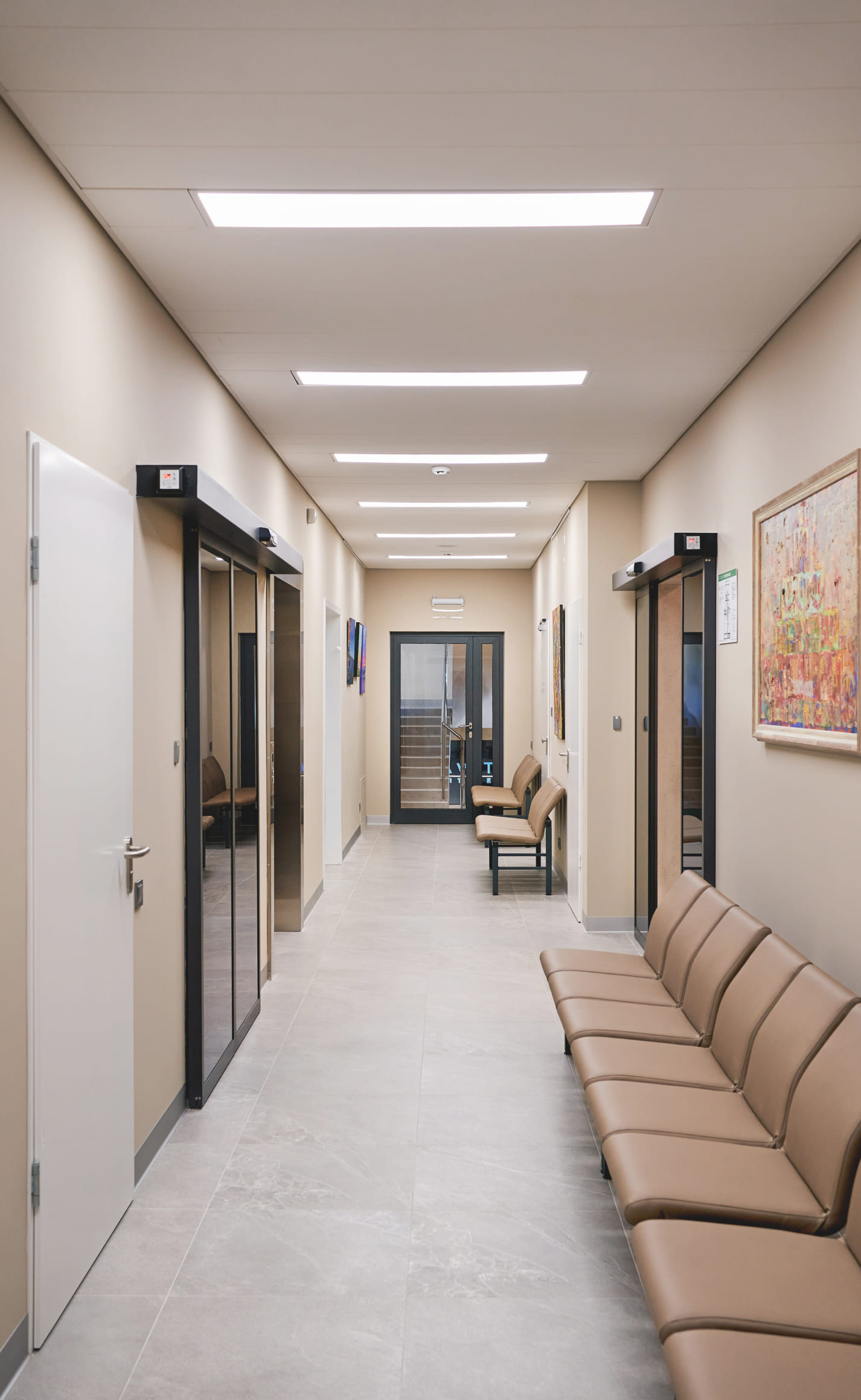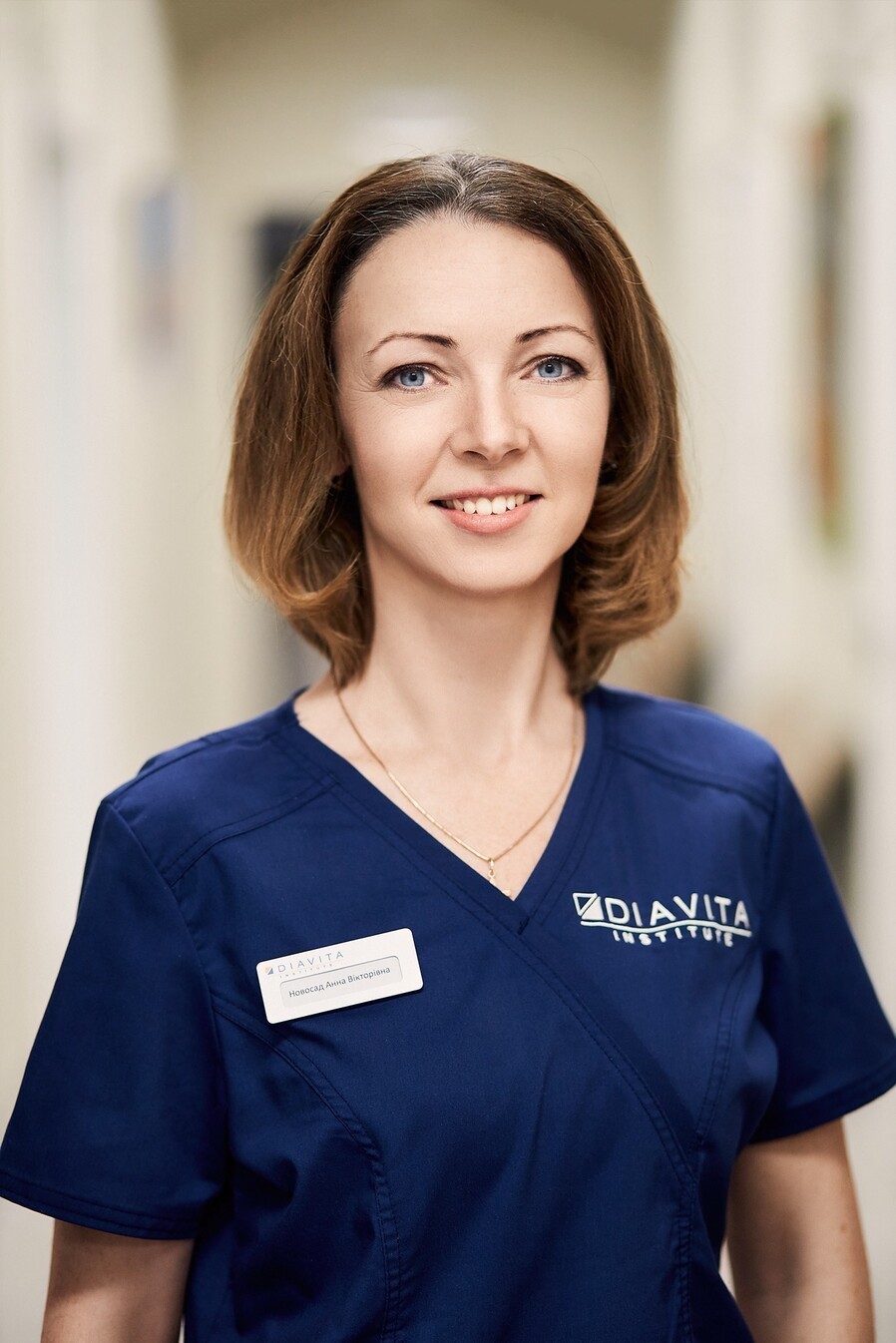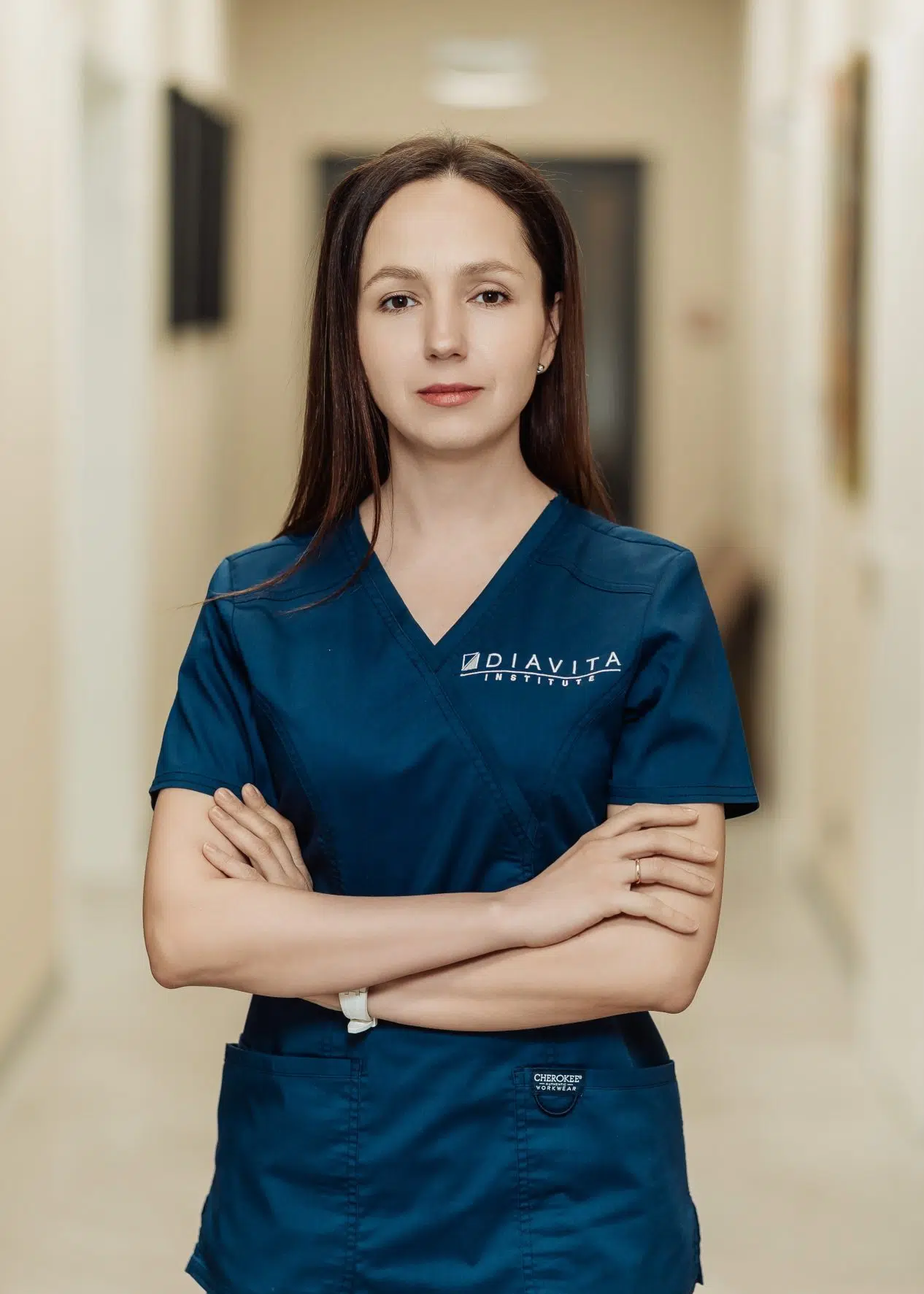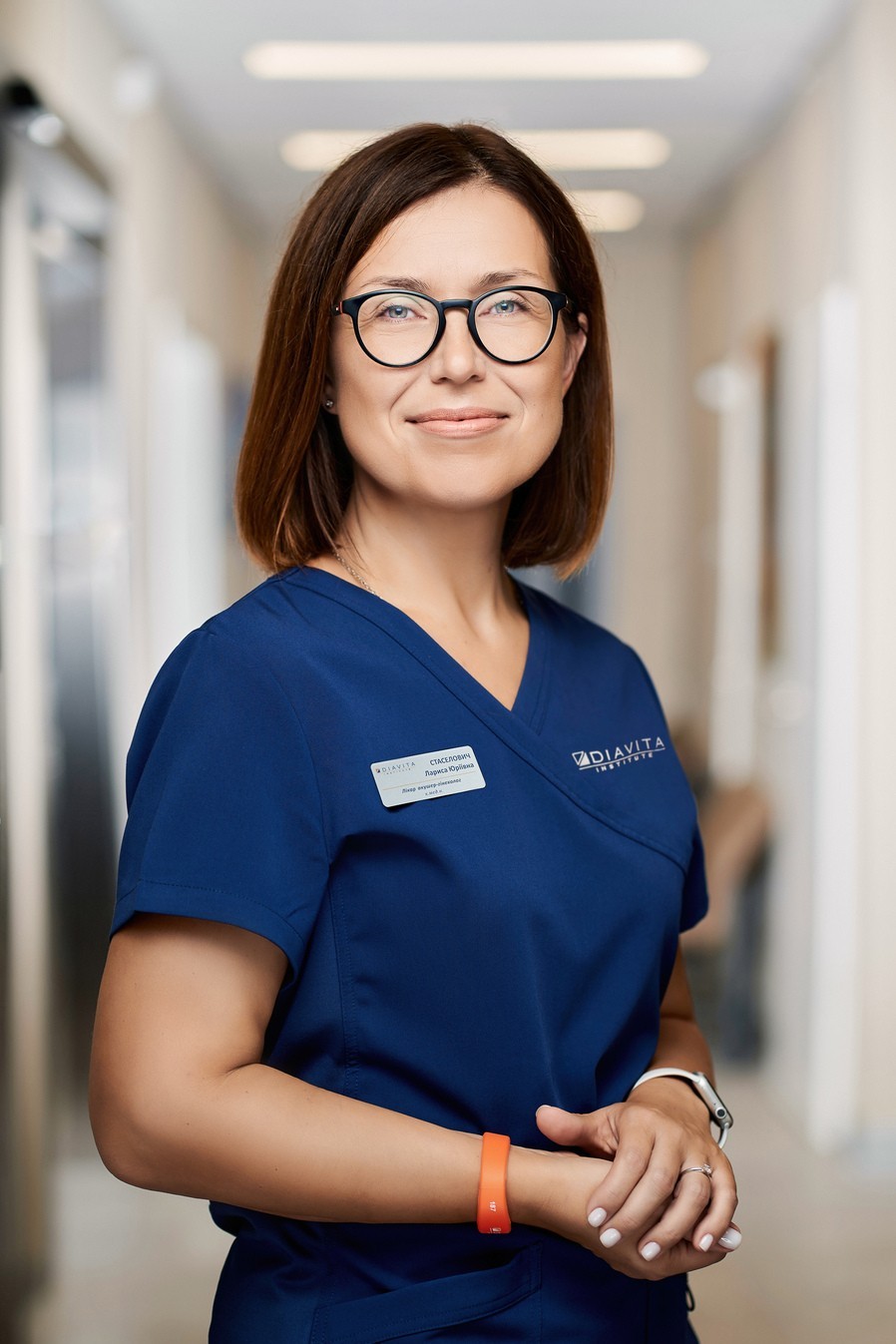
Laparoscopy in Kyiv - expert-class surgical gynecology
Gynecological surgery: laparoscopy, minimally invasive treatment with maximum effectivenessWhat is laparoscopy?
Лапароскопія — сучасний малоінвазивний метод хірургічного втручання, який дозволяє точно діагностувати та лікувати гінекологічні патології через невеликі проколи (5 – 10 мм). Завдяки використанню високоточної оптики з багатократним збільшенням та спеціальних інструментів лікарі Diavita Institute виконують складні операції з мінімальним травмуванням тканин, що забезпечує швидке відновлення пацієнток та можливість в короткі терміни повернутись до звичного способу життя.
Areas of laparoscopic surgery in gynecology
1. Treatment of ovarian cysts
Laparoscopy is the "gold standard" for removing cystic formations of various types:
-
Functional/follicular cysts: Removal/drainage of the cyst with minimal impact on the glandular tissue of the ovary.
-
Dermoid cysts: Effective removal with prevention of recurrence risks.
-
Endometrioid: Laparoscopic removal of endometrial tissue located inside or on the surface of the ovary, as complete removal of the capsule of the “chocolate” cyst as possible to prevent recurrence.
-
Serous and mucinous cystadenomas: Detailed diagnostics followed by removal, which allows you to preserve ovarian function.
Після операції зберігається репродуктивна функція, а відновлення займає 7 – 10 днів.
2. Laparoscopic surgery for infertility
Adhesions are removed, the patency of the uterine (fallopian) tubes is restored, ovarian drilling is performed, etc. For example, hydrosalpinx is characterized by the accumulation of fluid in the fallopian tube, which can cause infertility or pain. Laparoscopy allows:
-
Salpingostomy: Creating an opening for fluid drainage, reducing inflammation, and improving microcirculation.
-
Fimbriolysis and fallopian tube reconstruction: Restoring the patency of the fimbriae (cilia) to ensure normal tubular function.
-
Salpingectomy: Removal of a damaged tube in case of irreversible changes (before IVF).
Лапароскопія дозволяє зберегти або відновити фертильність, а також запобігти запальним ускладненням. Комплексний підхід разом з урологами багатопрофільної експертної команди Діавіта Інститут забезпечує ефективність та результативність лікування пари.
3. Treatment of uterine fibroids
Uterine fibroids are benign tumors that can cause severe pain, bleeding, and other symptoms. The possibilities of laparoscopy allow:
-
Localized myomatous node: Preservation of healthy uterine tissues.
-
To perform a myomectomy: Surgical removal of one or more nodes with minimal scarring.
-
Use modern coagulation methods: Reducing the risk of bleeding and other complications.
The surgery is especially recommended for women planning a pregnancy.
4. Treatment of endometriosis
Laparoscopy is the gold standard in the diagnosis and treatment of endometriosis:
-
Excision of lesions: Removal of endometrioid implants to effectively reduce pain and prevent further spread of the disease.
- Coagulation: Cauterization of small foci.
-
Treatment of adhesions: Separation of adhesions between pelvic organs to restore normal anatomy.
Лапароскопія дозволяє відновити анатомію органів та зменшити симптоми на 80 – 90%.
5. Ectopic pregnancy
- Linear salpingotomy/withsegmental resection: In some cases, the pipe is cut or a section of it is removed with subsequent reconstruction.
- Salpingectomy: Removal of the entire fallopian tube (if it is impossible to perform a salpingotomy or for other indications).
Fast and effective resolution of critical conditions using minimally invasive methods.
Minimally invasive technologies for complex diagnostic and therapeutic tasks
Лапароскопія — сучасний малотравматичний метод оперативної гінекології, який дозволяє гінекологам-хірургам Diavita Institute вирішувати найскладніші гінекологічні проблеми через проколи розміром 5–10 мм. Завдяки використанню оптики високої роздільної здатності, мікроінструментів та енергетичних систем (радіочастота, біполярна хірургія, Ligasure) процедура є мінімально травматичною, але максимально ефективною при лікуванні широкого спектра патологій жіночої репродуктивної системи. Лапароскопія не лише дозволяє уникнути великих розрізів, але й зменшує ризик ускладнень у 3 – 4 рази порівняно з відкритими операціями.
-
Minimal trauma: Small incisions ensure minimal tissue damage and reduce blood loss, which promotes effective healing.
-
Quick recovery: Patients can return to their usual routine just a few days after laparoscopy.
-
High diagnostic accuracy: Modern optical equipment makes it possible to visualize and study the condition of the pelvic organs in detail.
-
Reducing the risk of postoperative complications: Thanks to the minimally traumatic technique, the procedure is characterized by a reduced risk of adhesions and a low probability of developing infectious and other complications.
-
Aesthetic result: маленькі проколи майже непомітні після загоєння та забезпечують кращий косметичний ефект порівняно з традиційними відкритими хірургічними методами.
-
Reducing pain: Minimal tissue trauma ensures a low level of postoperative pain.
-
Short-term hospitalization: більшість процедур проводяться в умовах денного стаціонару, отже дозволяють швидке відновлення та повернення до звичайних ритмів життя.
Laparoscopic surgery is an effective method that may be recommended for the treatment and diagnosis of the following conditions:
-
Cysts and nOvarian pathology: Detailed diagnostics and effective surgical removal.
-
Fallopian tubes: Dissection of adhesions/adhesions in the pelvis, treatment of hydrosalpinx, surgery of the fallopian tubes.
-
Uterine fibroids: Effective surgical treatment.
- Ectopic pregnancy: diagnostics and timely treatment.
-
Endometriosis: To remove abnormal cells and scar tissue.
-
Chronic pelvic pain: Identifying and treating the source of pain.
-
Diagnostic laparoscopy and dinvestigation of the causes of infertility: It is performed to assess the anatomy of the pelvis (ovaries, uterus, fallopian tubes, and other structures), helps identify the causes of infertility, pathologies that affect reproductive function (endometriosis and inflammatory processes), and provides planning for further treatment measures.
Лапароскопія в Diavita Institute – це безпека, технології та турбота про ваш комфорт.
If you feel the need for more information or wish to undergo laparoscopy, please contact our manager for free consultation regarding laparoscopy through a convenient contact form on the website or by phone. Modern sterile operating rooms, individual supply and exhaust ventilation system with HEPA filters and air conditioning, console systems from Trumpf and Baxter, electrosurgery from Covidien, equipment from Storz, anesthesia equipment from Draeger - only the best for your safety and effective treatment.
Modern anesthesiology and anesthesia
One of the important aspects of performing laparoscopy is ensuring the safety and comfort of the patient using modern anesthesia methods.
-
Types of anesthesia: The procedure is usually performed under general inhalation anesthetic, which allows the patient to remain completely asleep throughout the procedure.
-
Condition monitoring: During the operation, an experienced anesthesiologist from Diavita Institute constantly monitors vital signs and adjusts the depth of anesthesia, which guarantees maximum safety and painlessness.
-
Preparation and postoperative recovery: The patient receives clear instructions on preparation for surgery, food and fluid intake. Immediately after the intervention, the patient is under the supervision of an anesthesiologist with mandatory monitoring of vital functions in the recovery room. The anesthesiologist also provides instructions on rehabilitation after the procedure to prevent possible complications associated with anesthesia.
Don't put off your health for later!
At Diavita Institute you will receive:
- Detailed treatment plan.
- Effective surgical treatment performed by experts and, if necessary, recording the stages of the operation on a medium.
- Support during the rehabilitation phase.
We are ready to provide qualified assistance, provide detailed advice on all issues, and offer the optimal solution for your health.
View check-up package offers:
More information about gynecology with comfort and other services
Preparing for laparoscopy: a detailed plan
To ensure successful surgical intervention, it is necessary to:
-
Full medical examination: Includes consultations with Diavita Institute specialists (gynecologist, anesthesiologist, and others), ultrasound examination, ECG, and blood tests (general, coagulogram, biochemical parameters).
-
Compliance with recommendations: Diavita Institute doctors provide clear instructions on preparation, including food and fluid intake, and determine the need to use compression stockings to prevent thrombosis.
-
History assessment: Analysis of previous illnesses, surgeries, and allergic reactions to ensure the safety of the procedure.
-
Psychological preparation: Providing support and counseling to reduce stress levels before surgery.
-
Preoperative examination: Detailed diagnostic preparation includes ultrasound, blood tests, and consultations with specialists.
-
Preparation for surgery: The patient receives recommendations at Diavita Institute regarding the diet and fluid intake before surgery, the specifics of medication preparation, and other safety measures.
-
Anesthesia: The operation is performed under general anesthesia, which ensures maximum comfort during the intervention.
-
Surgical intervention: Through several small punctures, a laparoscope and special mini-tools are inserted, allowing the surgeon to work with maximum precision. To achieve optimal results and minimal invasiveness, Diavita Institute gynecological surgeons use modern bipolar electrosurgery techniques, including Ligasure.
-
Completion of the procedure: After the surgical steps are completed, the instruments are removed and the small incisions are closed with cosmetic sutures.
Rehabilitation after laparoscopy: personal recommendations
After laparoscopy, the patient may experience minor discomfort, which usually subsides within a few days. Key recommendations:
-
Rest: Ensure rest and minimal physical activity in the first few days after surgery.
-
Diet: A light diet rich in protein, fiber, and vitamins is recommended to aid recovery.
-
Medical care: Taking painkillers and anti-inflammatory drugs as recommended by a Diavita Institute doctor.
-
Control inspection: Regular visits to the Diavita Institute doctor to monitor the recovery process and prevent possible complications. Control ultrasound to evaluate the results after 1 month. Pregnancy planning (if necessary).
-
Physical activity: Поступове введення легких фізичних вправ після отримання дозволу лікаря, уникати фізичних навантажень та підняття важких предметів (понад 3 кг) зазвичай протягом 2 – 3 тижнів.
-
Highly qualified specialists: A team of experienced gynecologists-surgeons with many years of practice. Our experts are integrated into the international community of specialists and use the most modern approaches, sharing their experience in Ukraine and in global professional circles.
-
Modern equipment: Using advanced technologies and equipment to ensure maximum accuracy and safety of procedures.
-
Individual approach: A personalized treatment plan developed by Diavita Institute doctors taking into account the characteristics of each patient.
-
Comprehensive support: Повна підтримка на всіх етапах лікування – від попереднього обстеження до реабілітації після операції.
-
Comfort and safety: The comfort of the treatment rooms, ensuring high standards of sterility, and minimizing the invasiveness of interventions contribute to faster recovery and reduced risks.







